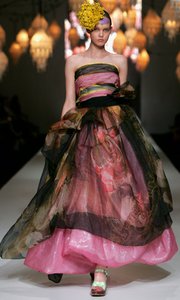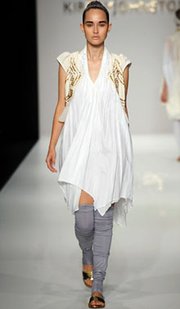A Parallel Fashion Universe Down Under
An L.A. Take on Australian Fashion Week
If Los Angeles has a sister fashion city, surely it’s Sydney, Australia. From the April 28–May 2 run of Rosemount Australian Fashion Week to the boutiques of Sydney, the parallels in the two markets are strikingly similar.
With nearly year-round sunny skies, a beach lifestyle, celebrities, health-conscious consumers and a culture that relies on cars for transport, it’s no wonder Sydney’s fashion industry resembles the Los Angeles market.
On the runway, designers showed a diverse mix: everything from swimwear to contemporary dresses, directional men’s lines and gowns suited for a red-carpet frockfest. A free-spirited approach pervaded the collections, and fashion trends ranged from brights and colorful prints to globe-trekker chic. Some featured masculine-inspired tailoring and others an androgynous, hipster edge. RAFW features top designers from all across Australia, and it is the region’s largest showcase of established and emerging design talent in the Asia Pacific. It has become the key stop for many on the international fashion-week circuit and falls under the umbrella of IMG Fashion, organizer of fashionweek events in Los Angeles, New York, Miami, Berlin and Mumbai, India.
The Sydney event—which has grown from a combined 30 runway and exhibition shows during its inception in 1996 (when it was then known as Mercedes Australian Fashion Week) to more than 100 designers showing on the runway this season—has garnered international attention. “Australia and the Asia Pacific really is a focal point of international awareness, with so much attention focused on the economic growth expectation of the region,” said Simon Lock, managing director of IMG Fashion Asia Pacific in a prepared statement.
This season, established designers such as Alex Perry, Wayne Cooper, Akira Isogawa, Lisa Ho, Anna Thomas, Nicola Finetti, Easton Pearson and Zimmermann showed their collections, as well as New Zealand–based Kate Sylvester and Thai label Stretsis. Emerging labels such as Antipodium, Romance Was Born, Friedrich Gray and Material Boy also joined the lineup. And designers who have made waves internationally, Michelle Jank and Sass & Bide , returned from Paris and New York, respectively, to show on the catwalk in Sydney.
Designers were set up to not only show their collections but to also do business. In total, 170 designers showcased their collections in runway shows and at various locations onsite and offsite, including the Emerge@The Source boutique exhibition area, the Boutique Showrooms@ RAFW, the RAFW Agent Designer Suites at The Westin Sydney and the RAFW Showrooms@MCA. New Zealand labels were showcased nearby at the Billich Gallery, andthe eco-friendly Gorman Ship Shop was set up outsideRAFW’s Overseas Passenger Terminal venue.
The unique, diverse range of products at the event attracted registered international buyers from 15 countries, including Canada, the United Kingdom, Hong Kong, Indonesia, Ireland, Singapore, Japan, United Arab Emirates, Russia and the United States. There were more than 100 international buyers from retailers such as Lane Crawford, Selfridges, Villa Moda, Urban Outfitters, Browns, Shop Bop and American Rag Cie. Accordingto Austrade, fashion exports are worth approximately $240 million to Australia’s economy. “Fashion is one of Australia’s key creative and design industries, and we know there are over 2,000 active fashion exporters delivering their products and services in the overseas markets,” said Lucy Coward, senior export adviser for Austrade’s consumer industry team, in a prepared statement.
Australia has a host of star designers and labels— including Collette Dinnigan, Insight, Sass & Bide and Ksubi—not to mention international surf brands Billabong, Ripcurl and Quiksilver, which have their roots in Oz but have helped define American surf culture.
Coming from a multicultural population and varied lifestyles, Australian designers offer a range of fashion, from casual to sophisticated. Armed with an entrepreneurial spirit, an irreverent approach to fashion and inspiration culled from the diverse Australian landscape, Down Under designers are gearing up for globalization.
Mark Werts, founder and chief executive officer of American Rag, began shopping the Australian market seven years ago. During a yearly company-wide meeting, American Rag’s Japan-based stores tipped Wertz off to a then-new Sydney-based denim line called Ksubi. The hot tip sparked a love affair with Australian designers, which has resulted in biannual buying trips. According to Werts, American Rag stocks a large percentage of Australian lines, including Life With Bird, Zimmermannand Shakuhachi. The designer lineup changes each season based on product. “There are so many new brands coming, and it’s like a moving target. There are some that come in, and some go out; some have good seasons, some have bad, and so we change,” Werts explained.
The lifestyle approach to design in Sydney is similar to the Los Angeles ethos of casual chic. Comfortable transseasonal clothes fit the bill and work perfectly to fill in between seasonal deliveries, according to Werts. “It’s been seven years; we come twice a year, and the brands sell. So it’s real easy,” he said. “The seasons are opposite, so we can fill in gaps,” he explained.
In addition, Australian brands’ lifestyle concept fits the resortwear look that has become increasingly important for American Rag’s store at Fashion Island in Newport Beach, Calif.
This season, Werts and women’s buyer Ruthie Miller picked up swimwear lines such as Kini Bikini, Flamingo Sands and the new Hotel Bondi Swim line, which launched on the runway at RAFW. But the Australian market isn’t just about beachwear. Designer labels Camilla and Marc, Ginger & Smart and Sass & Bide offer chic ready-to-wear collections, and designers such as Wayne Cooper, Jayson Brundson and Alex Perry create high-end fashion and exquisite evening gowns. “We’re very wellknown for surfwear and streetwear, and I think we do that really, really well,” Brundson said. “I think what the world is now waking up to is the idea that we don’t just do that. We also do glamorous clothes and clothes for events, as well.”
While the world market is becoming more global and trends cross borders and continents, many Spring/Summer trends on the runway in Sydney translate easily to the Los Angeles market. “I think consumers in California are very similar in some senses to consumers here in Sydney,” Lock said. Styles on the runway ranged from bodyrevealing sheer chiffons and floral prints at Zimmermann to flirty frocks and chic blazers at Camilla and Marc and relaxed, easy-to-wear tailored suits and short ensembles at Lisa Ho. S&B vie by Sass & Bide featured layered looks with skin-tight leggings, a.k.a. “black rats,” which designer Heidi Middleton dubbed as the “new jean.”
Belinda Seper, owner of the high-end multi-label Belinda boutiques and The Corner Shop stores in Australia, has also found a crossover with the Australian and Los Angeles markets. Seper shops the world for fashion and over the past several years has stocked her stores with various Los Angeles–based lines, including Rozae Nichols, Velvet and Corey Lynn Calter. Seper is also the distributor of St. Grace and Citizens of Humanity in Australia. “I think what we have to offer would probably appear more lifestyle-driven than what one tends to see on the runways of New York, Paris or Milan simply because it’s clothing for our lifestyle,” Seper said. “It’s really about a reflection of the way we live our life here in Australia.”
In today’s challenging retail environment, the weak dollar-to-euro exchange rate is also working in favor of the Australian market. The Australian dollar is almost equal to the U.S. dollar, providing more value to buyers looking to maximize profit in a tough economy, although prices of Australian products have also gone up due to inflation and the increase in the price of fabrics. Brundson said when he started selling to the United States, the exchange rate was $.70 to the U.S. dollar. Now it’s almost even. As a result, the price of clothes has increased, which has caused some price resistance among U.S. buyers who aren’t prepared to spend more than they did a year or two ago. “It’s hard to export into the States at the moment and try and keep the price points that you want to try to keep to,” Brundson said.
For American Rag, the Australian market is proving more viable than Europe presently. “The euro is so expensive that we’re seeking other sources of supply,” Werts said. “We think the dollar-euro relationship is a distortion and won’t be this way forever, but it is for now, and so during this time we have to seek other sources,” he explained.

























